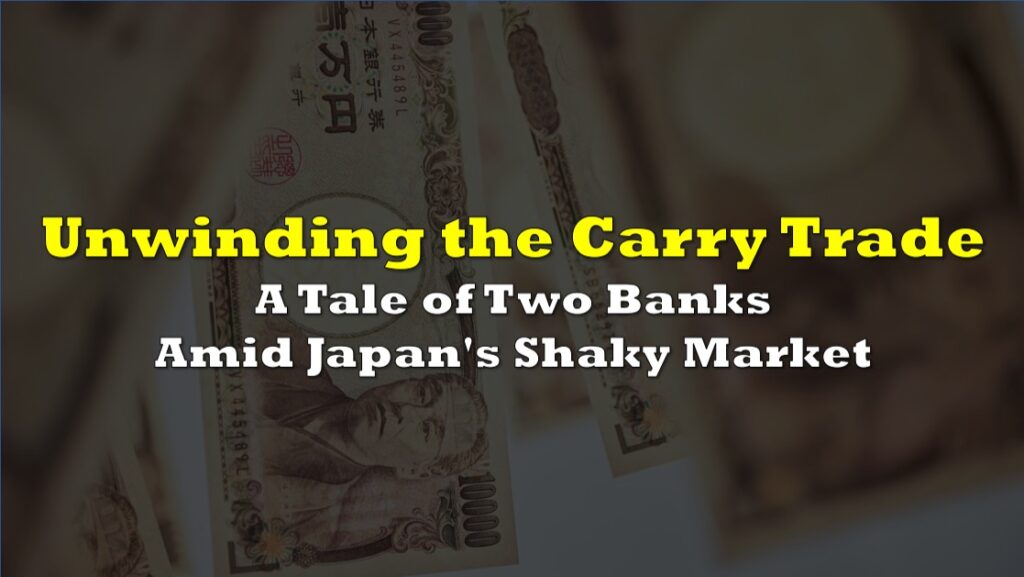Right now markets are imploding.
Japan’s Nikkei just had the worst day since 1987, falling as much as 12.4% – that’s basically their entire market – before recovering to a mild 7% loss.
This was after two days of 5% declines. Here at home, the Nasdaq composite fell over 3.4% and the S&P500 tumbled 3%. So what’s happening?
The Japan carry trade is exploding.
What is the Japan carry trade?
In short, it works like this. Japan’s interest rates traditionally have been very low, while the Yen was also weak. So what investors would do, is they would borrow funds in Japanese Yen, convert it to US Dollars, and then buy assets with those cheap dollars – primarily stocks, bonds, and crypto.
With a history of rock bottom interest rates and extremely limited volatility, shorting the Yen to buy risk assets was viewed as a safe bet. This trade has historically worked so well, that trillions of yen are estimated to have been borrowed and converted to buy these assets.

The breaking of the carry trade
However every trade has risks. And after fifteen years of near and sub-zero rates, the Bank of Japan earlier this year was forced to raise rates due to inflation pressures at home, ending an eight year period of negative interest rates.
In March, rates were raised by just 10 basis points in an effort to calm inflation. But that wasn’t enough, forcing the Bank of Japan to take a drastic action – they raised rates by 25 basis points, the largest increase since 2007.
Now, rates sit at 0.25% in Japan. Still low by North American standards, but now investors need to actually earn a return on their investment for the carry trade to make sense.

At the same time, the Bank of Japan indicated that it is open to further interest rate hikes, while stating that it plans to reduce their Japanese Government Bond holdings. The country will reduce monthly purchases of bonds from 6 trillion yen per month to just 3 trillion yen per month, which will be done gradually over 2 years.
Basically, every month from here on out will see monthly purchases cut by 400 billion yen, until the new target is achieved. In other words, quantitative tightening. Which is good for combating inflation. Not so good if you’re currently short the yen.

Monetary policy impact
So what is the impact of raising rates and introducing quantitative tightening, while other economies around the world are returning to rate cuts and quantitative easing?
Your currency gets a lift.
Which is somewhat what the BoJ wanted – in April and May they intervened in the currency markets and defend the 160 level with the dollar, spending $9.8 trillion in the process to do so. And earlier in July they spent a further 5.5 trillion Yen to again defend that level, prior to raising rates.
But here’s the thing.
What happens when a stock that is heavily shorted gets some positive momentum? You get a squeeze. GameStop should have taught the average investor that by now. Currencies are no different. It’s just a bit more complex. Right now, amid market turmoil, we’re basically caught in a short squeeze on the Yen.

Carry trade implosion
With the price of the Yen relative to USD rising, investors are seeing the returns on their investments implode. Let’s put this into context, borrowing the figures from a recent tweet by X user Rho Rider, who uses crypto for the example.
Last Monday, you borrowed Yen at 0% interest, swapped it to $10 million in US dollars, and bought $10 million worth of bitcoin. With rising rates in Japan and a stronger Yen, that $10 million USD is worth 7% less in Yen. And your debt is in Yen, so that means you’re down 7% as is.
So you now have a gap of $700,000 that you need to make up for. So you sell your bitcoin to get back US dollars, which will then be converted to Yen to settle your debt. But here’s the thing. You aren’t the only one caught short here. There’s trillions of dollars out there that are all trying to stop their losses.. by selling their assets.
So the price of bitcoin is down, and your position tanked by $2.0 million. Now your losses are at $2.7 million. On a $10 million trade. And to settle your debt, what do you need to do? Sell other assets to make up the difference to settle the score. Just like everyone else has to, driving down the price of any liquid asset.
It’s one big negative feedback loop, which is why markets – stocks, bonds, and crypto alike – are crashing.
In closing
Where does it all end?
Well, Elizabeth Warren on Friday was already calling for emergency rate cuts from the Fed in an effort to spur investment. And that was before things imploded further today.
And as one final “oofta”, here’s a chart of the magnificent 7 as compared to the chart of the USD/JPY.
Gentle reminder that the 🇯🇵 yen carry helped fund–among other things–massive buying of US tech stocks.
— Motorhead (@BradMunchen) August 5, 2024
Here's the $JPY vs the Magnificent 7 since the huge run began in early January 2023. pic.twitter.com/gL2LuMJAAf
So you probably get the idea of where we’re headed from here.
For the rest of us, all we can do is sit back and watch the implosion as it happens, and hope we don’t get hammered too hard.
Information for this story was found via the sources and companies mentioned. The author has no securities or affiliations related to the organizations discussed. Not a recommendation to buy or sell. Always do additional research and consult a professional before purchasing a security. The author holds no licenses.






One Response
Whoa! Volatility indeed, got out of the stock market last year – was a gut feeling with the way things were playing out worldwide. Tumultuous times ahead people, get prepared!!